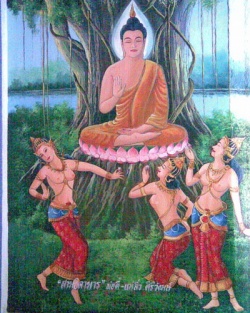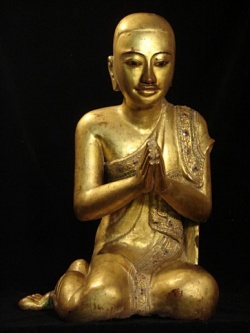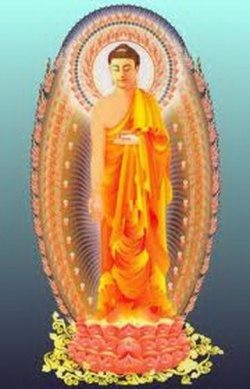Saṃyojana
saṃyojana: 'fetters'. There are 10 fetters tying beings to the wheel of existence, namely:
(1) personality-belief (sakkāya-diṭṭhi, q.v.),
(2) sceptical doubt (vicikicchā q.v.),
(3) clinging to mere rules and ritual (sīlabbata-parāmāsa; s. upādāna),
(4) sensuous craving (kāma-rāga, 4.v.),
(5) ill-will (byāpāda),
(6) craving for fine-material existence (rūpa-rāga),
(7) craving for immaterial existence (arūpa-rāga),
(8) conceit (māna, q.v.),
(9) restlessness (uddhacca, q.v.),
(10) ignorance (avijjā, q.v.).
The first five of these are called 'lower fetters' (orambhāgiya-saṃyojana), as they tie to the sensuous world. The latter 5 are called 'higher fetters' (uddhambhāgiya-saṃyojana), as they tie to the higher worlds, i.e. the fine-material and immaterial world (A. IX, 67, 68; X. 13; D . 33, etc.).
He who is free from 1-3 is a Sotāpanna, or Stream-winner, i.e. one who has entered the stream to Nibbāna, as it were. He who, besides these 3 fetters, has overcome 4 and 5 in their grosser form, is called a Sakadāgāmi, a 'Once-returner' (to this sensuous world). He who is fully freed from 1-5 is an Anāgāmī, or 'Non-returner' (to the sensuous world). He who is freed from all the 10 fetters is called an Arahat, i.e. a perfectly Holy One.
(Sanskrit; Pāli, binding). A restriction or limitation, usually translated as a ‘fetter’, in the sense of something that binds one to saṃsāra or the cycle of rebirth. There are said to be ten:
(1) belief in a permanent self (satkāya-dṛṣṭi);
(2) sceptical doubt (vicikitsā);
(3) obsession with rules and rituals (śīlavrata-parāmārśa);
(4) sensous craving (kāma-rāga);
(5) hatred (vyāpāda);
(6) craving (rāga) for the Form Realm (rūpa-dhātu);
(7) craving for the Formless Realm (ārūpya-dhātu);
(8) conceit (asmi-māna);
(9) restlessness (uddhatya);
(10) ignorance (avidyā).
The first five are known as ‘lower fetters’ since they bind one to rebirth in the Desire Realm (kāma-dhātu); the second five are known as ‘higher fetters’ since they bind one to rebirth in the Form and Formless Realms. The four noble persons (ārya-pudgala) have freed themselves of a different number of fetters: the stream-winner (śrotāpanna) is free of the first three; the once-returner (sakṛdāgāmin) is also free of the grosser forms of four and five; the non-returner (anāgāmin) is completely free of the first five, and the Arhat is free of all ten.
For more details, s. ariya-puggala.
The 10 fetters as enumerated in the Abhidhamma, e.g. Vibh. XVII, are: sensuous craving, ill-will, conceit, wrong views, skeptical doubt, clinging to mere rules and ritual, craving for existence, envy, stinginess, ignorance.
saṃyojana (saṃyojana) fetters. Sam + yuj means to bind firmly. Hence saṃyojana means that which binds. The ten fetters in the Suttanta method are(1) illusion about the soul (satkāya dṛṣṭi) (sakkāya-diṭṭhi),
(2) sceptical doubt (vicikitsā) (vicikicchā),
(3) attachment to rules and rituals (śīlavrata-parāmarśa) (sīlabbata parāmāsa),
(4) sensuous craving (kāmarāga) (kāmarāga),
(5) aversion (pratigha) (paṭigha),
(6) clinging to the realms of form (rūpa-rāga) (rūparāga),
(7) clinging to the formless realms (arūparāga) (arūparāga),
(8) pride (māna) māna,
(9) restlessness (auddhatya) (uddhacca), and
(10) ignorance (avidyā) avijjā.
The first three fetters are known as trīṇi saṃyojanāni, the three fetters. The first five fetters are known as (avarabhāgiya) (orambhāgiya) lower fetters because they pertain to the sensuous world. The latter five are known as ūrdhvabhāgiya (uddhambhāgiya), the higher fetters because they pertain to the realms of form and the formless realms. Satkāya-dṛṣṭi means to believe in the existence of a permanent entity -- the soul of the living-beings. Vicikitsā means to have doubts about the Buddha, the dharma, the saṅgha, the disciplinary rules, the past, the future, both the past and the future, and the Dependent Origination. The stream-enterer (srotāpanna) eradicates the first three fetters. In addition to the eradication of these three, the 'once-returner' (sakṛdāgāmī) uproots the fourth and the fifth fetters in their gross form. The 'non-returner' (anāgāmī) has completely uprooted these five fetters. The Arhat is totally free from each and every fetter. A different enumeration of saṃyojana-s is found in the Abhidhamma method. It is as follows
(1) sensuous craving (kāmarāga),
(2) anger (pratigha) (paṭigha),
(3) pride (māna),
(4) illusion about the self (dṛṣṭi),
(5) skeptical doubts (vicikitsā),
(6) false views (śīlavrata-parāmarśa),
(7) desire for existence (bhavarāga),
(8) jealousy (īrṣyā) (issā),
(9) avarice (mātsarya) (macchariya), and
(10) ignorance (avidyā).
Aṭṭhasālinī. I. 349, 357; III. 474; IV. 563; A Comprehensive Manual of Abhidhamma. VII. 268-269; IX. 362-363. Dīgha Nikāya. Saṅgīti. Majjhima Nikāya. Mahāmālukya. Saṃyutta Nikāya. Orambhāgiya, Udhambhāgiya.
saṃyojana
(Sanskrit; Pāli, binding). A restriction or limitation, usually translated as a ‘fetter’, in the sense of something that binds one to saṃsāra or the cycle of rebirth. There are said to be ten:
(1) belief in a permanent self (satkāya-dṛṣṭi);
(2) sceptical doubt (vicikitsā);
(3) obsession with rules and rituals (śīlavrata-parāmārśa);
(4) sensous craving (kāma-rāga);
(5) hatred (vyāpāda);
(6) craving (rāga) for the Form Realm (rūpa-dhātu);
(7) craving for the Formless Realm (ārūpya-dhātu);
(8) conceit (asmi-māna);
(9) restlessness (uddhatya);
(10) ignorance (avidyā).
The first five are known as ‘lower fetters’ since they bind one to rebirth in the Desire Realm (kāma-dhātu); the second five are known as ‘higher fetters’ since they bind one to rebirth in the Form and Formless Realms. The four noble persons (ārya-pudgala) have freed themselves of a different number of fetters: the stream-winner (śrotāpanna) is free of the first three; the once-returner (sakṛdāgāmin) is also free of the grosser forms of four and five; the non-returner (anāgāmin) is completely free of the first five, and the Arhat is free of all ten.
Saŋyojana (nt.) [fr. saŋyuñjati) bond, fetter S iv.163 etc.; especially the fetters that bind man to the wheel of transmigration Vin i.183; S i.23; v.241, 251; A i.264; iii.443; iv.7 sq. (diṭṭhi˚); M i.483; Dh 370; It 8 (taṇhā); Sn 62, 74, 621; J i.275; ii.22; Nett 49; DhA iii.298; iv.49.
The ten fetters are
(1) sakkāyadiṭṭhi;
(2) vicikicchā;
(3) sīlabbataparāmāso;
(4) kāmacchando;
(5) vyāpādo;
(6) rūparāgo;
(7) arūparāgo;
(8) māno;
(9) uddhaccaŋ;
(10) avijjā.
The first three are the tīṇi saŋyojanāni <-> e. g. M i.9; A i.231, 233; D i.156; ii.92 sq., 252; iii.107, 132, 216; S v.357, 376, 406; Pug 12, 15; Nett 14; Dhs 1002; DA i.312. The seven last are the satta saŋyojanāni, Nett. 14. The first five are called orambhāgiyāni -- e. g. A i.232 sq.; ii.5, 133; v.17; D i.156; ii.92, 252; M i.432; S v.61, 69; Th 2, 165; Pug 17. The last five are called uddhambhāgiyāni <-> e. g. A v.17; S v.61, 69; Th 2, 167; ThA 159; Pug 22; Nett 14, 49.
A different enumeration of the ten saŋyojanas, at Nd2 657=Dhs 1113, 1463 (kāmarāga, paṭigha, māna, diṭṭhi, vicikicchā, sīlabbataparāmāsa, bhavarāga, issā, macchariya, avijjā); compare, however, Dhs 1002.
A diff. enumn of seven saŋyojanas at D iii.254 & A iv.7, viz. anunaya˚, paṭigha˚, diṭṭhi˚, vicikicchā˚, māna˚, bhavarāga˚, avijjā˚. A list of eight is found at M i.361 sq. Cp. also ajjhatta -- saŋyojano & bahiddhāsaŋyojano puggalo A i.63 sq.; Pug 22; kiŋ -- su -- s˚ S i.39= Sn 1108.
saṃ-ḍyójana n. the act of joining or uniting with (instr. or loc.) ŚBr. &c. &c
• all that binds to the world, cause of rebirth, Divyâ-v
• copulation, sexual union L
• (with mitrā-varuṇayoḥ, aśvinoḥ, and prahitoḥ N. of Sāmans ĀrshBr.





